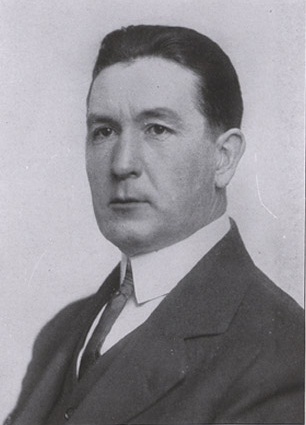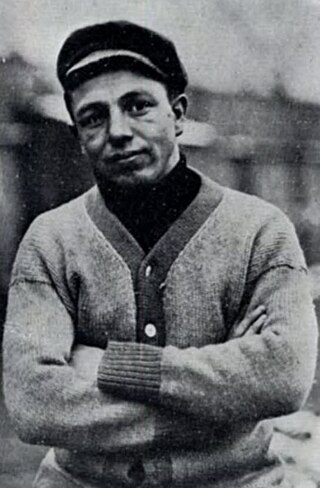Related Research Articles

Edward James "Doc" Stewart was an American football, basketball, and baseball player, coach, and college athletics administrator. He was also the founder, and player-coach of the Massillon Tigers professional football team.
Walter Rufus East was a minor league baseball player active between 1903 and 1912. As a second baseman he played for various in the Southern Association, Eastern League, Missouri Valley League, Ohio State League and the Ohio–Pennsylvania League. East however also managed several minor league teams from the Ohio–Pennsylvania League.
Homer Hurd Davidson was a professional Major League Baseball player for the Cleveland Naps. Born in Cleveland, Ohio, he played only 6 games for the Naps during the 1908 season. Davidson was better known as a professional football player. He played in the Ohio League, which was the direct predecessor to the modern National Football League. One veteran Ohio sportswriter once rated Davidson to be the equal of Walter Eckersall, an infamous quarterback from the University of Chicago. He attended college at the University of Pennsylvania and played on the Penn Quakers baseball team.
The Canton Bulldogs–Massillon Tigers betting scandal was the first major scandal in professional football in the United States. It refers to a series of allegations made by a Massillon, Ohio newspaper charging the Canton Bulldogs coach, Blondy Wallace, and Massillon Tigers end, Walter East, of conspiring to fix a two-game series between the two clubs. One account of the scandal called for Canton to win the first game and Massillon was to win the second, forcing a third game—with the biggest gate—to be played legitimately, with the 1906 Ohio League championship at stake. Another account accused Wallace and East of bribing Massillon players to throw a game in the series. Canton denied the charges, maintaining that Massillon only wanted to damage the club's reputation. Although Massillon could not prove that Canton had indeed thrown the second game and it remains unknown if there was ever a match-fixing agreement, the scandal tarnished the Bulldogs name and reportedly helped ruin professional football in Ohio until the mid-1910s.

Charles Edgar "Blondy" Wallace was an early professional football player and later convicted criminal during the Prohibition Era. He was a 240-pound, former Walter Camp second-team All-American tackle from the University of Pennsylvania. He also played two years at Peddie Institute, in New Jersey, winning state championships in 1896 and 1897. During his professional playing career he was involved in almost every major event in professional football between 1902 and 1907. Over that timespan he played for the independent Philadelphia Athletic Club, the Philadelphia Athletics of the first National Football League, the "New York" team and the Syracuse Athletic Club in the 1902 World Series of Football, the Franklin Athletic Club and the Canton Bulldogs of the Ohio League. In 2022, he was named one of the 10 inaugural members for the Football Learning Academy's Hall of Honor, which looks to acknowledge deserving icons that are not currently inducted in the Pro Football Hall of Fame.
The Massillon Tigers were an early professional football team from Massillon, Ohio. Playing in the "Ohio League", the team was a rival to the pre-National Football League version of the Canton Bulldogs. The Tigers won Ohio League championships in 1903, 1904, 1905, and 1906, then merged to become "All-Massillons" to win another title in 1907. The team returned as the Tigers in 1915 but, with the reemergence of the Bulldogs, only won one more Ohio League title. Pro football was popularized in Ohio when the amateur Massillon Tigers hired four Pittsburgh pros to play in the season-ending game against Akron. At the same time, pro football declined in the Pittsburgh area, and the emphasis on the pro game moved west from Pennsylvania to Ohio.
Jack Cusack was an American professional football manager in the Ohio League. He served as the manager and owner of the Canton Bulldogs from 1912 to 1918. During his six years with the Canton Bulldogs, Cusack led the team to Ohio League championships in 1916 and 1917, and was responsible for bringing Jim Thorpe into professional football. Cusack also is responsible for helping revive the Bulldogs following the Canton Bulldogs-Massillon Tigers Betting Scandal, which eroded public support for the game from 1906 until 1911. He also ensured that the Bulldogs had a sturdy financial foundation for when they would later enter the National Football League (NFL). In 1918, Cusack left football to enter the oil and gasoline business in Oklahoma. He later worked as an independent oil operator in Fort Worth, Texas.

George Watson "Peggy" Parratt was a professional football player who played in the "Ohio League" prior to its becoming a part of the National Football League (NFL). Born in Cleveland, Ohio, Parratt played quarterback for the Shelby Blues, Lorain Pros, Massillon Tigers, Massillon All-Stars, Franklin Athletic Club of Cleveland, Akron Indians and the Cleveland Tigers between 1905 and 1916. Parratt threw the first legal forward pass in professional football history while playing for the Massillon Tigers on October 25, 1906.
Charles Robert Shiring was a professional football player from Pittsburgh, Pennsylvania. He began his professional playing career with the Homestead Library & Athletic Club in 1901. In 1902, he played for the Pittsburgh Stars of the first National Football League (NFL) who ended up winning the league title. Since the Stars consisted of the best professional players from western Pennsylvania at the time, it can be said that Shiring was considered the best at his position, center, in the region. However Shiring is best known for playing for the Massillon Tigers from 1903 until 1907. He finally served from 1907 to 1910 as a player-coach for the Pittsburgh Lyceum, Pittsburgh's last championship professional football team until the 1970s.
Pro Football: Its Ups and Downs, published in 1934, is a book by Dr. Harry March that was the first ever attempt to write a history of professional American football. March had served in several executive offices with the New York Giants of the National Football League in the late 1920s and was a founder of the second American Football League. The book, while popular and entertaining with some important information and interesting anecdotes, is often viewed as inaccurate by modern sports historians. Jack Cusack, manager of the Canton Bulldogs from 1912 to 1917, summed up the book's flaws by stating; "In my library is a book... entitled Pro Football: Its "Ups and Downs" and in my opinion it is something of a historical novel."
Edwin Kimmell Wood was an early professional football player for the Latrobe Athletic Association, the Franklin Athletic Club and finally for the Canton Bulldogs of the "Ohio League". He also played on Dave Berry's Western Pennsylvania All-Star team, a collection of early football star players, that was designed to compete with the star-heavy Duquesne Country and Athletic Club on December 3, 1898, at Exposition Park in Pittsburgh. In 1902 he played in the first National Football League for the Philadelphia Phillies. He also played for Franklin when it won the 1903 World Series of Football over the Watertown Red & Black at Madison Square Garden. Wood later became one of the first professional players to catch forward passes when they became legal in 1906.
Dan Policowski was an early professional football player for the Massillon Tigers from 1904 to 1906. Originally from Canton, Ohio, which was the home of the Tigers', rival the Canton Bulldogs, Policowski played end under the alias Dan Riley. He was also known as "Bullet Riley".
Herman Charles Kerkhoff was a professional American football player from the mid 1890s until 1906.
Sherburne Henry Wightman was a professional American football player-coach in the "Ohio League", which was the direct predecessor to the modern National Football League (NFL). He is best remembered for coaching the Massillon Tigers to an Ohio League title in 1906, over the Canton Bulldogs, which led to accusations of a betting scandal. In 1907, he coached a version of the Massillon Tigers called the "All-Massillons" to another Ohio League title. Prior to his professional career, Wightman played at the college level for the Chicago Maroons, under Amos Alonzo Stagg, and Swarthmore College.
Clark A. Schrontz was a professional American football player. In 1902 he won a championship in the first National Football League (NFL) with the Pittsburgh Stars. A year later he was a member of the Franklin Athletic Club football team that was considered the "best in the world". He also won the 1903 World Series of Football, held at Madison Square Garden, with the Franklin Athletic Club.
John Lang was a professional American football player. In 1902 he won a championship in the first National Football League with the Pittsburgh Stars. A year later he was a member of the Franklin Athletic Club football team that was considered the "best in the world". He also won the 1903 World Series of Football, held at Madison Square Garden, with the Franklin Athletic Club.
The 1906 Canton Bulldogs season was their second season in the Ohio League. The team finished 10–1, giving them second place in the league. The championship series between the Bulldogs and the Massillon Tigers was rumoured to be fixed.
The 1915 Canton Bulldogs season was their sixth season that the Canton Bulldogs franchise competed in the Ohio League, a professional American football sports league. For the first time since 1906, that the team was once again called the "Bulldogs". The season also marked the arrival of the legendary Jim Thorpe to the Canton lineup. The team finished with a known record of 5–2 and a share of the Ohio League title with the Massillon Tigers and the Youngstown Patricians.
The 1915 Massillon Tigers football season was the sixth season of competition for the Massillon Tigers franchise, and their first season since 1907. The team posted a 5–2 record and obtained a share of the 1915 Ohio League Championship, with the Canton Bulldogs and the Youngstown Patricians.
The Canton Bulldogs were a professional American football team, based in Canton, Ohio. They played in the Ohio League from 1903 to 1906 and 1911 to 1919, and the American Professional Football Association, from 1920 to 1923, and again from 1925 to 1926. The Bulldogs won the 1916, 1917, and 1919 Ohio League championships. They were the NFL champions in 1922 and 1923. In 1921–1923, the Bulldogs played 25 straight games without a defeat. This remains an NFL record.
References
- "Blondy Wallace and the Biggest Football Scandal Ever" (PDF). PFRA Annual. 5. Professional Football Researchers Association: 1–16. 1984. Archived from the original (PDF) on December 18, 2010.